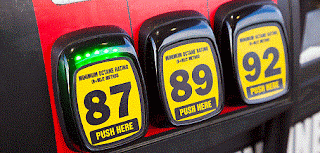 |
| Octane Rating |
The rewrite job takes on an ancient (in internet terms) version written by Jonathan McClelland, in which the sometime screenwriter did a workmanlike job¹ of explaining how octane is calculated and the applications of the different fuels. Kozlowski attempted to reword and expand McClelland's version, in the process – of course – attempting to add some chemistry to the text. Sadly, the effort fell short.
Right out of the box, Kozlowski demonstrated a surprising lack of mathematical knowledge in the section she called "Types of Gasoline," telling her readers,
"Fuel is considered by [sic] grade levels and ranked by octane rating. This octane rating is actually an average, noted below:Regular gas: 87 octane rating, average 85 to 88Mid-grade or plus gas: 89 octane rating, average 88 to 90Premium gas: 92 octane rating, average 91 to 94"
For starters, we have no idea what that "considered by" is supposed to mean, but it pales alongside the inanity of a "statistic" such as, "Regular gas: 87 octane rating, average 85 to 88." In the first place, an octane rating is an average of two different methods for measuring octane (research and motor octane); in the second place, we're pretty certain our nominee was trying to say "range 85 to 88" instead of "average 85 to 88."
More hilarity ensued as Kozlowski attempted to tell us that,
"The octane rating is the ratio of heptane to isooctane. An octane rating of 87 is 87 percent isooctane and 13 percent heptane."
Even if that were correct, which it's not, in a mixture of 87% isooctane and 13% heptane the "ratio of heptane to isooctane" is 13/87, or about 0.15. In reality, octane is (approximately) one minus the percentage of heptane present. Duh: Kozlowski merely parroted an incorrect factoid found on a few dozen websites. If you want to know more about the topic from an accurate source, you could always visit one of the references Rosann cited (but apparently didn't read).
Other bogosity included,
- "...octane rating is a measure of the fuel’s stability and anti-knocking ability." – No, it's a proxy for said ability; not a "measure."
- "...knocking or pings happen when there is non-uniform combustion causing irregular pressure waves in a cylinder." – We think she means "incomplete combustion," but what do we know? And what is this "pressure waves" bullshit, anyway?
Kozlowski missed a chance to mention the effect of adding ethanol to gasoline, which results in increased octane. We guess the omission was because McClelland didn't mention it, so she didn't know. You'd think our Dumbass of the Day would have run across such important information... had she actually researched the subject.
¹ Meaning: not very many mistakes
SI - AUTOMOTIVE
No comments:
Post a Comment